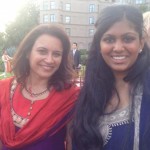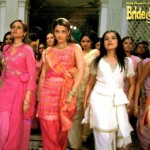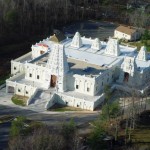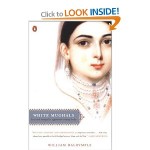
Last weekend I took a long flight with my daughter to a fabulous Indian family wedding with all the bells and whistles. It was a four-day celebration. Although we missed the first night’s cocktail party, we rolled in the next night for the sangeet, a dance party with live Indian music, henna tattoos, a costume jewelry bazaar, and a delicious buffet of authentic Indian dishes I’ve never seen in restaurants. A day of family and friends socializing and grand rehearsal dinner followed. On the penultimate day, bhangra-bopping friends and relatives surrounded the brocade-coated groom who rode across the hotel lawn on a white horse with with golden hoofs. Garlands of roses and marigolds wilted in ninety-degree temperatures, but the guests endured with parasols and fans. In the middle of the Hindu rites, waiters discreetly served the seated guests saucers of sherbet.
There was no scandal or disruption. The bride and groom’s families were both thrilled with the young couple’s moral character, accomplishments, and commitment to each other.
In short–it was like the best kind of wedding out of an upbeat Indian film. But despite the heat and background music, the setting was not the New Delhi of Monsoon Wedding or the Amritsar of Bride and Prejudice. It was a luxury hotel just outside Los Angeles.

On the wedding ceremony morning, the Sri Lankan hair stylist who was spraying my hair into a suitable design was stunned that I’d never been to a South Asian wedding before. I explained this was because our family settled in the U.S. during the 1960s, a time when Indian immigrants were mostly scientists and engineers. Only in the last twenty years have thousands of Indians with an entrepreneurial bent settled in the United States, giving rise to full-scale Indian weddings.
In my childhood, we shopped for basmati rice and dal at a Middle-Eastern store, because there was no such thing as the South Asian specialty grocer. My sisters and I were excited to study bharatnatyam, the classical dance, but the classes held in an urban park community center were discontinued for lack of numbers. Whenever the Indian professor families in our area wanted to celebrate an Indian religious holiday, they rented space from a Catholic students’ organization. Not enough affluent Indian families had arrived yet to enable the funding of this era’s massive gurdwaras, temples and mosques.

Not only are the numbers of Indian cultural centers growing, so is the blending with America. On Sundays, the New York Times always has announcements of young Indian-Americans marrying outside their religion and race. In Los Angeles, the Protestant American groom’s family even wore the formal embroidered silk clothing the bride’s mother had bought for them in Bombay—as well as the nine bridesmaids and seven groomsmen. They performed Indian dances at the sangeet and at the ceremony, listened attentively to the Sanskrit prayers, which the Hindu priest translated into English, so everyone would understand.
As I sat under the California sun with the bride’s family, it seemed to me that Anglo-Indian weddings have come full circle. In the 1600s, When the bachelor officers of the British, Dutch and Portuguese East India companies arrived in India, their most important contacts were women. Young Indian women, who lived with them and taught them the language and the manners they needed to succeed in their specific part of the subcontinent, were sometimes called Sleeping Dictionaries because they were both bedmates and language teachers. Many of the bachelor officers fell in love and married their companions, living completely in the manner of Indian aristocrats. William Dalrymple’s historical account of such people,

White Mughals, explains this lifestyle with fascinating detail. Many of the Anglo-Indian sons born of such parents in India were sent to England for higher education, so they could have good careers, and the daughters were married off to prominent English colonials.
But as British still living in England got wind of these multi-cultural marriages, they disapproved. A campaign arose to send English girls in their late teens and twenties to find husbands among the East India company men. Such young ladies were teasingly called the Fishing Fleet, and most of them did land catches of some sort. This social engineering dramatically raised the numbers of British families living in India. Now, the growing Anglo-Indian society was suddenly declasse. The British couldn’t knowingly socialize with Anglo-Indians,let alone continue the custom of interracial marriage. And Anglo-Indians were similarly disparaged by the Indian community, who’d taken note that they’d adopted the language, clothing, and religion of the colonists, and enjoyed the benefit of jobs set aside only for them in the Indian Railways.
After World War II ended in Britain’s favor, its government finally granted independence to India. From 1947 onward, many Anglo-Indians left India to resettle in Britain and Canada. And Indians too had the chance to travel for higher education and jobs. But prejudice was there. It was sometimes hard for Indian students to find landlords willing to rent to Indians, and mixed-race couples were often targets of verbal insults.
Given the unpredictable situation in the U.K., my parents–a European and an Indian in a mixed marriage–crossed the Atlantic, seeking a home where their daughters would hopefully not face that kind of discrimination. And while I do have some hurtful experiences in my past, what is more powerful is my wonder at the number of non-Indians around me wearing bindis on their foreheads and mehndi on their hands, who are mixing India into all kinds of parties and celebrations, just for the fun of it.

Very interesting to read you blog post, And we come from a similar back ground though in 1947 my Anglo Indian Grandparents settle in England UK. My Grandpa Bert Scott was a Press photographer for Times of India then in Indian army. You can read about that on my blog if you wish under My Family History, there is also a half and hour doc I made for British TV when I returned to India with him. Once again nice to read you post. Jason Tilley
Hi Jason, this is exactly the kind of journey I’m interested in exploring for the second book in my series. I would love to see the documentary, is there any way it’s on the internet anywhere?